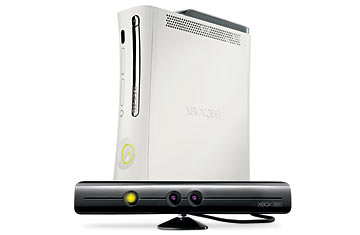
Microsoft's new Xbox
(2 of 2)
The result is ... impressive. You start getting impressed when you walk in front of the thing and it immediately recognizes your face and logs you in. Very Star Trek. A few months ago Microsoft demoed Project Natal for Steven Spielberg, who in addition to directing movies designs video games, including Medal of Honor and the Wii title Boom Blox. He's one of the few movie people who really gets games as an insider, and Microsoft was looking for his blessing. He gave it. "The technology recognized me as a full person," he says. "It identified me, my legs, my arms, all of my movements, not just my wrists and my fists, and my thumbs, which is the current state of the art. This recognized my entire person and in a way accepted all of me as a competitor inside the gamespace." (See the 10 worst video-game movies of all time. )
Let the games begin. I had a chance to play a simple dodgeball-type game called Ricochet, in which you just punch and kick and head balls at a three-dimensional wall. It's weird to be playing a game with nothing in your hands — if you've ever played a theremin, the sensation of playing with Project Natal is not dissimilar. It's spooky. But it's also very immersive. When a ball comes bounding at your head and you butt it back with your forehead, you can almost feel the smack of it against your skin. "It was the most tactile experience I've had so far in a gaming space," Spielberg says. "I got a sense that I was inside the space more than I have on any other platform."
Kipman also showed me a version of Burnout that had been set up to work with Project Natal. Burnout is a serious game, not just a tech demo — it's a polished, fast-paced racing game with high-end graphics, and I happen to have played a lot of it. With Project Natal, instead of using a joystick, you steer by holding your hands up in the air like you're gripping a steering wheel. To hit the gas, you move your foot forward along the floor. To brake, you move it back. To trigger the turbo boost, you do a gear-shifting, fist-pumping movement with your right arm. Awesome.
It takes a few minutes to get the hang of it. You tend to oversteer, since you can't quite believe this thing is going to pick up your movements, so you exaggerate them. But soon you start to trust it, because it does actually work. I couldn't detect any significant latency. And there's definitely an extra edge to playing a game with nothing between you and the screen but your clenched, white-knuckled fists. I'm a hard-core gamer, so I'm not the person Project Natal is targeting. I love my controller as it is. But the appeal of Project Natal is real. You could compare it to the difference between regular movies and 3-D movies: it puts you in the action in a way that nothing else could.
Of course, the success of Project Natal ultimately depends on whether developers embrace it and write decent games for it. Today game developers all over the world have got their little Project Natal starter kits, and it's up to them to figure out what this stuff is good for. I saw a demo cooked up by Peter Molyneux (Black & White, Fable) in which you chat with a realistic-looking little boy. He recognizes your face and what color your clothes are, and he follows you with his eyes. If you walk over to a pond, you can ripple the water by moving your fingers across it. If you lean over it, you see your reflection. Freaky. "I think it's the next step after Wii," Spielberg says. "The Wii platform is totally engaging and awe-inspiring. But this is one step beyond that."
